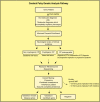Mendelian etiologies identified with whole exome sequencing in cerebral palsy
- PMID: 35076175
- PMCID: PMC8862420
- DOI: 10.1002/acn3.51506
Mendelian etiologies identified with whole exome sequencing in cerebral palsy
Abstract
Objectives: Cerebral palsy (CP) is the most common childhood motor disability, yet its link to single-gene disorders is under-characterized. To explore the genetic landscape of CP, we conducted whole exome sequencing (WES) in a cohort of patients with CP.
Methods: We performed comprehensive phenotyping and WES on a prospective cohort of individuals with cryptogenic CP (who meet criteria for CP; have no risk factors), non-cryptogenic CP (who meet criteria for CP; have at least one risk factor), and CP masqueraders (who could be diagnosed with CP, but have regression/progressive symptoms). We characterized motor phenotypes, ascertained medical comorbidities, and classified brain MRIs. We analyzed WES data using an institutional pipeline.
Results: We included 50 probands in this analysis (20 females, 30 males). Twenty-four had cryptogenic CP, 20 had non-cryptogenic CP, five had CP masquerader classification, and one had unknown classification. Hypotonic-ataxic subtype showed a difference in prevalence across the classification groups (p = 0.01). Twenty-six percent of participants (13/50) had a pathogenic/likely pathogenic variant in 13 unique genes (ECHS1, SATB2, ZMYM2, ADAT3, COL4A1, THOC2, SLC16A2, SPAST, POLR2A, GNAO1, PDHX, ACADM, ATL1), including one patient with two genetic disorders (ACADM, PDHX) and two patients with a SPAST-related disorder. The CP masquerader category had the highest diagnostic yield (n = 3/5, 60%), followed by the cryptogenic CP category (n = 7/24, 29%). Fifteen percent of patients with non-cryptogenic CP (n = 3/20) had a Mendelian disorder on WES.
Interpretation: WES demonstrated a significant prevalence of Mendelian disorders in individuals clinically diagnosed with CP, including in individuals with known CP risk factors.
© 2022 The Authors. Annals of Clinical and Translational Neurology published by Wiley Periodicals LLC on behalf of American Neurological Association.
Conflict of interest statement
DEF: DEF has received grants from CureAP4 Foundation, CureSPG50 Foundation, BPAN Warriors Foundation, Thrasher Research Fund, NIH/NINDS, Tom Wahlig Foundation, Astellas Pharmaceuticals, Mitobridge Inc., The Manton Center for Orphan Disease Research. Received royalties from Cambridge University Press. Received consulting fees from Alcimed Inc. Received honoraria from International Parkinson and Movement Disorder Society. MCK: MCK has received grant support from PTC Therapeutics; consulting fees from PTC Therapeutics, Aeglea, Merz; participated on board for Aeglea and Merz. AP: AP has received support from the Boston Children's Hospital Translational Research Fund. SS: SS has received grants from NIH/NINDS; consulting fees from GLG, Guidepoint (which connected to a client, Fortress Biotech), Novartis, ExpertConnect, Orchard Therapeutics.
Figures
References
-
- Krigger KW. Cerebral palsy: an overview. Am Fam Physician. 2006;73(1):91‐100. - PubMed
-
- Rosenbaum P, Paneth N, Leviton A, et al. A report: the definition and classification of cerebral palsy April 2006. Dev Med Child Neurol Suppl. 2007;109:8‐14. - PubMed
-
- Sukhov A, Wu Y, Xing G, Smith LH, Gilbert WM. Risk factors associated with cerebral palsy in preterm infants. J Matern Fetal Neonatal Med. 2012;25(1):53‐57. - PubMed
-
- Mukerji A, Shah V, Shah PS. Periventricular/intraventricular hemorrhage and neurodevelopmental outcomes: a meta‐analysis. Pediatrics. 2015;136(6):1132‐1143. - PubMed
-
- Bolisetty S, Dhawan A, Abdel‐Latif M, et al. Intraventricular hemorrhage and neurodevelopmental outcomes in extreme preterm infants. Pediatrics. 2014;133(1):55‐62. - PubMed
Publication types
MeSH terms
Grants and funding
LinkOut - more resources
Full Text Sources
Medical
Miscellaneous


